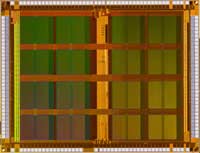The memory chip industry has made significant strides with the release of the MRAM MR2A16A by the American company Freescale, which can store information like a hard drive, operating independently of power supply.
 |
|
Freescale’s MRAM MR2A16A. Image: LinuxDevices |
Magnetoresistive Random Access Memory (MRAM) can preserve information in digital cameras, mobile phones, printers, and more, even if the power supply is abruptly cut off. This type of chip is developed based on Magnetic Tunnel Junction (MTJ) technology.
Static RAM (SRAM) and Dynamic RAM (DRAM) are widely used and offer fast access speeds but lose data when power is interrupted. Flash technology can also store information without power; however, MRAM operates faster, has no limitations on read-write cycles, and boasts a longer lifespan than flash chips.
Freescale’s MR2A16A version is a 4 megabit device, operating at 3.3 volts with a read-write cycle of 35 nanoseconds (ns) per cycle.
“Magnetic memory has been around in hard drives for a long time, but this is the first time we’ve integrated this technology with a semiconductor to create a new type of storage product,” said Saied Tehrani, Director of the MRAM division at Freescale. “MRAM has been mentioned since the 1990s, and we have been in a very intense race to be the first company to bring this product to market.”
Texas Instruments (USA) had previously introduced high-capacity iron-containing FRAM (Ferroelectric Random Access Memory) chips, which also store information without needing a power supply. However, this chip is currently only applied in limited specific fields.


















































